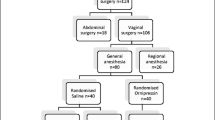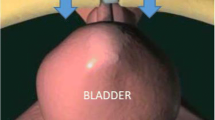Abstract
To survey the practice and reasons of use of local infiltration in prolapse and continence surgery in UK, an electronic survey of gynaecologists with special interest in urogynaecology, urogynaecologists, urologists and allied professionals who were on the email list of the International Continence Society (ICS), UK was carried out in April-July 2006. Out of the 238 questionnaires that were sent, 112 failed mail delivery and 57 questionnaires were returned, giving a response rate of 50.1%. Of the respondents, 40/46 (86.9%) used local infiltration for vaginal hysterectomy and vaginal repairs, whilst 43/46 (93.4%) used it for TVT. Of the respondents, all of 18 who performed vaginal mesh procedures used local infiltration. While 90% of respondents felt it helped reduce blood loss, only 46% were convinced that it helped reduce visceral injury. The survey reflects that the majority use local infiltration for gynaecological surgery: however, there is wide variation in the type and strengths of agents used.
Similar content being viewed by others
Introduction
Infiltration of local anaesthetic has been used for a very long time in vaginal and perineal surgery. Use of local infiltration which contains adrenaline has been traditionally used to reduce haemorrhage [1], but is known to be associated with tachyarrhythmias when accidentally injected into the vascular system.
A wide variety and concentration of agents are used for local infiltration. There seems to be no consensus on the type, concentration of agents and concomitant use of vasoconstrictor agents like adrenaline. There is a paucity of good quality data on outcomes like operation time, analgesia requirements, etc. when using local infiltration with or without vasoconstrictors. Our aim was to survey the practice and reasons of use of local infiltration in prolapse and continence surgery in UK.
Methods
An electronic survey of gynaecologists with special interest in urogynaecology, urogynaecologists, urologists and allied professionals who were on the email list of the International Continence Society (ICS), UK was carried out in April-July 2006. We included a personalised letter to the clinicians informing them of the objective of the survey. The survey was re-sent after 8 weeks to improve the response rate.
The survey was designed to obtain information on various issues relating to the practice of local infiltration in vaginal surgery. We included questions on the type of procedures in which the individual used local infiltration, the type of local anaesthetic used, with its volume and concentration and whether adrenaline was used concomitantly. We also wanted to explore the rationale behind the surgeon’s use of these agents. A Microsoft Excel database was used to store the responses.
Results
Out of the 238 questionnaires that were sent, 112 failed mail delivery and 57 questionnaires were returned, giving a response rate of 50.1%. Of these, seven were allied professionals or research fellows, two were urologists and only 46 completed the questionnaire. Of those who completed the questionnaire, ten were consultant urogynaecologists, two were subspecialists, 30 were gynaecologists with special interest in urogynaecology and four were subspecialty trainees in urogynaecology. Thirty-six respondents were willing to participate in a RCT, whilst four were yet undecided. Of the respondents, 11 used the British Society of Urogynaecology database, 26 were planning to start using it and nine neither used it nor had plans to use it.
Of the respondents, 40/46 (86.9%) used local infiltration for vaginal hysterectomy and vaginal repairs, whilst 43/46 (93.4%) used it for TVT. Of the respondents, all of 18 who performed mesh procedures like total vaginal mesh (TVM) used local infiltration. Table 1 gives the details of the number of surgeons who used local anaesthetic infiltration for various urogynaecological procedures.
Of the 46 respondents, 27 (58.7%) used normal saline in infiltration. The types of local anaesthetic used were lignocaine (22: 45.7%), prilocaine with octapressin (6: 13.6%), bupivacine (5: 11.4%), marcaine (4: 9.1%), prilocaine (3: 6.8%), chirocaine (1: 2.3%) and other (5: 10.9%) With regard to use of adrenaline, 42(90%) used it with local anaesthetic, and of the four who did not, three used octapressin instead. The most common concentration of adrenaline used was 1 in 1000 (31/42), though some surgeons (11/42) diluted it with normal saline to 1 in 100,000. Table 2 gives the details of rationale for using local infiltration in pelvic floor surgery by the respondents of this survey.
Discussion
The survey was designed with the intention of identifying variation in current practice for use of local infiltration, and perception of practitioners about its advantages. A response rate of 51% was achieved. The survey reflects that the majority use local infiltration for gynaecological surgery; however, there is wide variation in the type and strengths of agents used. Use of vasoconstrictors is common practice as well, but there was variation in the strength used. Whilst 90% respondents felt it helped reduce blood loss, only 46% were convinced that it helped reduce visceral injury. There is some literature to suggest that hydrodissection does not reduce the risk of visceral injury [2]. Almost half of the respondents (46%) felt that it provided some pain relief.
Gynaecological surgery is moving more and more towards daycare surgery, as it is financially much more viable and also associated with significantly less side effects when compared to surgery under general anaesthetic or spinal anaesthetic [3]. It would also be a choice where general anaesthetic or spinal anaesthetic is contraindicated because of medical conditions like asthma, cardiac disease, spinal problems, etc..
Though the majority of respondents felt that local infiltration provided better planes of dissection, there is no evidence to support this opinion in vaginal or other surgery [4].
The use of local anaesthetics does come with the possibility of side effects. The local side effects of most agents are restricted to bruising and temporary sensation of stinging or burning. Systemic toxicity manifests as severe numbness, dizziness, tinnitus, slurred speech, seizures, cardiac depression, etc. The toxic effects are usually due to accidental rapid intravenous infusion, rapid absorption and excessive use resulting in overdose. This can be avoided with use of right technique, concentration and total volume of agent. Care needs to be taken when selecting agents for very old people and for those with significant medical problems, using multiple medications where possibility of interactions exists.
Side effects emanating from the usage of local anaesthetic can be reduced by the use of vasoconstrictors, which reduces the speed of absorption by as much as 50%. Adrenaline, however, has side effects such as tachyarrythmias. A study on local infiltration of scalp showed that addition of 6% dextran to the mixture constitutes a protective mechanism against toxic systemic side effects by causing a significant reduction in the absorption of both adrenaline and lignocaine from the injection site [5]. Prilocaine with felypressin causes statistically significant fewer side effects like feeling faint and shaking; however, the blood loss is greater than that occurring with lignocaine and adrenaline [6].
There is evidence to support local anaesthetic use to reduce postoperative analgesic requirements in large loop excision of transformation zone and episiotomies [7, 8] There is some evidence to suggest the same in pelvic floor surgery, but the data are not very robust [9].
Earlier studies in the late 1950s showed a 58% reduction in blood loss and reduction of blood transfusion from four-fifths to one-third, [10] whilst another study showed an appreciable reduction in blood loss (27.7%) when epinephrine (1:200000) was used for local infiltration in vaginal hysterectomy and antero-posterior repair [11]. A study comparing the reduction in blood loss using two strengths of adrenaline versus no adrenaline in 175 cases of vaginal surgery concluded that adrenaline in strengths of 1: 120,000 and 1:240,000 showed a significant reduction in blood loss; but there was no statistical difference in the mean blood loss in the two groups [12]. There might be differences in outcomes like blood loss depending on the type of vasoconstrictor used [13]. However, there have been questions raised regarding the increased risk of infection with impairment of tissue defenses by vasoconstrictors in vaginal hysterectomies [14].
There is wide variation in the use of local anaesthetic and vasoconstrictors in pelvic floor surgery. There is a need for a robustly designed randomized controlled trial for use of local anaesthetic with and without vasoconstrictors in pelvic floor surgery to study outcomes like reduction in visceral injuries, reduction in operation time and postoperative analgesia requirements, as well as adverse events like tachyarrhytmias and infections.
References
Nosan M, Novak F, Mazovec M (1968) [The decrease of hemorrhages in vaginal hysterectomies through administration of adrenaline, octapressine, Por-8 and Pox-85]. Gynaecologia 165(1):21–30
Ghezzi F, Cromi A, Raio L, Bergamini V, Triacca P, Serati M et al (2005) Influence of the type of anesthesia and hydrodissection on the complication rate after tension-free vaginal tape procedure. Eur J Obstet Gynecol Reprod Biol 118(1):96–100
Segal JL, Owens G, Silva WA, Kleeman SD, Pauls R, Karram MM (2006) A randomized trial of local anesthesia with intravenous sedation vs general anesthesia for the vaginal correction of pelvic organ prolapse. Int Urogynecol J Pelvic Floor Dysfunct (Epub ahead of print)
Caliskan K, Nursal TZ, Yildirim S, Moray G, Torer N, Noyan T et al (2006) Hydrodissection with adrenaline-lidocaine-saline solution in laparoscopic cholecystectomy. Langenbecks Arch Surg 391(4):359–363
Adams HA, Biscoping J, Kafurke H, Muller H, Hoffmann B, Boerner U et al (1988) Influence of dextran on the absorption of adrenaline-containing lignocaine solutions: a protective mechanism in local anaesthesia. Br J Anaesth 60(6):645–650
Howells RE, Tucker H, Millinship J, Shroff JF, Dhar KK, Jones PW et al (2000) A comparison of the side effects of prilocaine with felypressin and lignocaine with adrenaline in large loop excision of the transformation zone of the cervix: results of a randomised trial. BJOG 107(1):28–32
Lee ET, Ozumba EN, Bevan JR (1986) A randomized trial of Citanest with Octapressin for relief of pain associated with laser vaporization of the cervix. Br J Obstet Gynaecol 93(9):967–969
Fyneface-Ogan S, Mato CN, Enyindah CE (2006) Postpartum perineal pain in primiparous women: a comparison of two local anaesthetic agents. Niger J Med 15(1):77–80
O'Neal MG, Beste T, Shackelford DP (2003) Utility of preemptive local analgesia in vaginal hysterectomy. Am J Obstet Gynecol 189(6):1539–1541
Lazar M, Kreiger H (1959) Blood loss in vaginal surgery: a comparative study. Obstet Gynecol 13(6):707–710
Chehab HE (1968) Decreasing the morbidity of vaginal hysterectomy. Obstet Gynecol 31(2):198–207
Schroeder HG, Evans JM (1969) Adrenaline infiltration in vaginal surgery. A statistical analysis of the effect on operative blood loss during methoxyflurane anaesthesia. Br J Anaesth 41(7):609–614
Bartos P, Popelka P, Adamcova P, Struppl D (2000) Adrenalin versus terlipressin: blood loss and cardiovascular side-effects in the vaginal part of laparoscopically-assisted vaginal hysterectomy or vaginal hysterectomy. Clin Exp Obstet Gynecol 27(3–4):182–184
England GT, Randall HW, Graves WL (1983) Impairment of tissue defenses by vasoconstrictors in vaginal hysterectomies. Obstet Gynecol 61(3):271–274
Author information
Authors and Affiliations
Corresponding author
Rights and permissions
About this article
Cite this article
Latthe, P., Kadian, S., Parsons, M. et al. Survey of use of local infiltration and vasoconstrictors in vaginal surgery. Gynecol Surg 4, 187–189 (2007). https://doi.org/10.1007/s10397-007-0289-2
Received:
Accepted:
Published:
Issue Date:
DOI: https://doi.org/10.1007/s10397-007-0289-2




